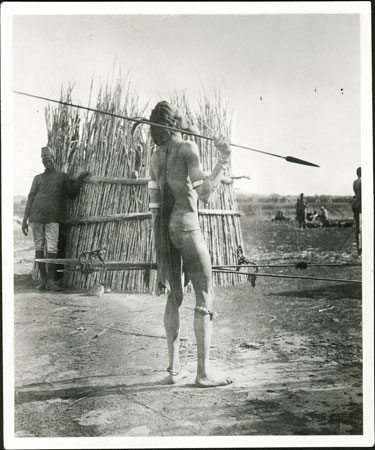Nuer prophet

108 x 90 mm | Print gelatin silver
Condition:
Sulphide staining overall [EE 1989]
Date of Print:
?1950s
Previous PRM Number:
EP.N.360
Accession Number:
1998.346.360
Description:
A relatively young Nuer prophet holding a spear aloft in his right hand, his face uplifted, showing the characteristic unkemptness of a prophet's beard and hair.
In his left hand by his side he holds a spear with a very large blade and another with a smaller blade, and a curved baton called dang with metal and attachments.
The dang was an instrument commonly used in wedding invocations, but was also associated with the prophet Ngundeng and thus became a symbol of spiritual power for subsequent prophets.
He also wears ivory arm ornaments and leg ornaments of large strung beads.
The prophet (guk) was a possessor of an air spirit (gwan kwoth) whom the Nuer greatly revered, but was a relatively unknown character before the mid 19th century, probably a result of the assimilation of Dinka people and their religious ideas.
Such men were considered to have spiritual powers such as healing.
Prophets were considered tirbal agitators by the government and were frequently persecuted.
Photographer:
Charles William Gwynn
Date of Photo:
?1900
Region:
[Southern Sudan] Upper Nile
Group:
Nuer ?Eastern Jikany
Publication History:
Contemporary Publication - Reproduced as Plate XV (facing page 306) in E.
E.
Evans-Pritchard's
Nuer Religion
(Oxford University Press 1974 [1957]) with the caption 'Prophet'.
[CM 22/8/2005]
PRM Source:
Edward Evan Evans-Pritchard
Acquired:
Donated 1966
Other Owners:
E. E. Evans-Pritchard Collection
Class:
Religion , Ritual , Weapon , Ornament , Ritual Object
Keyword:
Spear , Ornament Arm
Documentation:
Original catalogue lists in Manuscript Collections. Additional material in related documents files. [CM 27/9/2005]
Primary Documentation:
Accession Book Entry: [p.
98] 1966.27 [1 - 24] G[ift] PROFESSOR E.
E.
EVANS-PRITCHARD; INST.
OF SOCIAL ANTHROPOLOGY, 51 BANBURY RD.
OXFORD 1966.27.17 S.
SUDAN.
NUER TRIBE.
Box of negatives each in separate envelope, labelled.
(some missing).
Nos.
1 - 213.
(prints in box 1966.27.18)...1966.27.18 S.
SUDAN.
NUER TRIBE.
Box of prints each in separate envelope.
Nos.
1 - 213.
(negatives in 1966.27.17.)
Note on print reverse ms pencil - "[numerous printer's marks] please return, after use, to The Curator, Pitt Rivers Museum, parks Road, Oxford"
Note on print reverse ms pencil - "[numerous printer's marks] please return, after use, to The Curator, Pitt Rivers Museum, parks Road, Oxford"
Other Information:
In Nuer Religion (Oxford University Press 1974 [1957] 307) E.
E.
Evans-Pritchard notes that 'The photograph of a prophet in Plate XV was taken by Major-General Sir Charles Gwynn early in the present century.
We see from it how different is the appearance as well as the representation of a prophet from that of a priest!' [Chris Morton 11/5/2004] A similar baton, described as 'Ngundeng's baton' is reproduced as Fig 4 (p.108) in Douglas Johnson's Nuer Prophets (Clarendon Press, Oxford, 1994), where he also quotes Ngundeng's song that indicates that his dang was covered in blood after the battle of Pading.
[Chris Morton 12/5/2004] Charles W.
Gwynn (later Major-General Sir) was a Lieutenant in the Royal Engineers charged (along with a Lieutenant L.C.
Jackson) with demarcating the Sudan-Abyssinian border during 1899-1900, in particular the stretch between the Blue Nile and the Sobat River, demarcating areas of Abyssinian influence.
They had a native officer on the trip, one Farag Effendi, who only spoke Arabic, and may be the native officer seen to the left of the prophet in the image.
Their survey was carried out from north to south, arriving at Nasir in Feb 1900, where they marched downstream arriving at Fashoda on April 2nd.
[Chris Morton 17/5/2004] Note from Douglas Johnson [11/5/2004]: 'I do not know precisely where the photo was taken.
My guess that it was in the area around Jokau or Itang - in the Gaajak or Gaajok territory.
At that time there were a number of minor prophets in the border area, who were acknowledged dayiemni of Ngundeng.
However, I cannot say that this is a picture of a dayiem, or even a "prophet" in the sense that E-P used the term.
It is likely that Gwynn merely identified the person as a kujur, which could have covered a prophet (guk), subordinate prophet (dayiem), or magician (gwan wal).
Gwynn took a number of very good photographs during this survey, but I have been unable to find out where his photos were deposited.
They are not in the Institute of Royal Engineers in Chatham.
Gwynn died in Dublin (I checked his will at Somerset House), but I don't know if his photos, diaries or other papers were preserved anywhere.' [Chris Morton 17/5/2004]
Recorder:
Christopher Morton [17/5/2004] [Southern Sudan Project]

